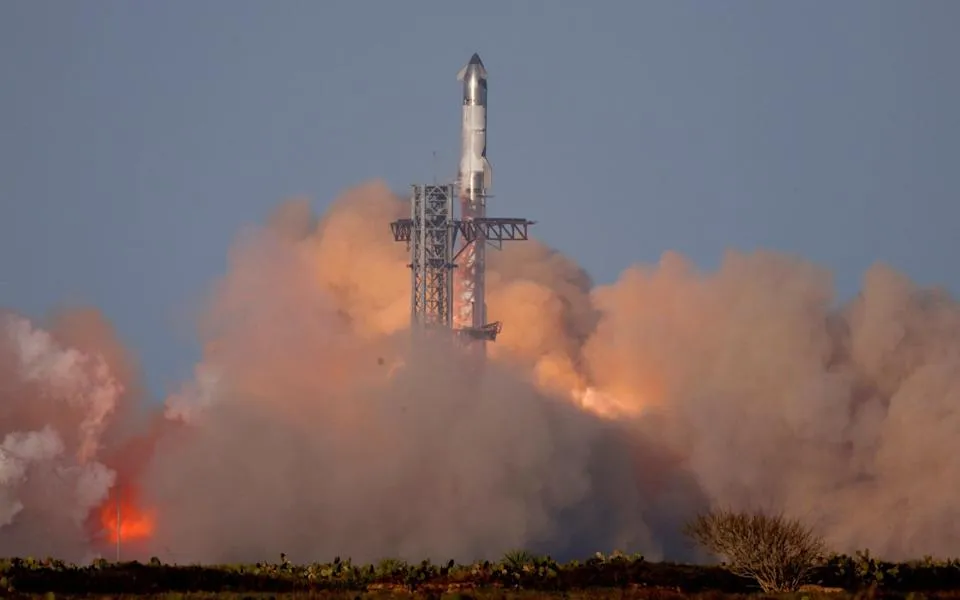

SpaceX Starship Fails: Debris from Elon Musk’s Mars Dream Disrupts Florida Flights
SpaceX’s ambitious Starship project, which Elon Musk envisions as the key to interplanetary travel, faced yet another challenge during its latest test flight. The upper stage of the Starship spacecraft exploded in space, causing debris to rain down over a vast area and disrupting air traffic across multiple U.S. states. Despite significant progress in rocket development, this failure raises crucial concerns about the reliability and future of the most powerful rocket ever built.
The Ambitious Vision Behind Starship
The Starship rocket system is the largest and most powerful rocket ever constructed. Standing at an astonishing 403 feet, it surpasses the height of the Statue of Liberty with its pedestal. It also boasts the highest number of engines in a single rocket booster—33 Raptor engines in the Super Heavy booster, producing a record-breaking 16 million pounds of thrust at full power.
Designed to carry humans to the Moon, Mars, and beyond, Starship is a crucial element in Musk’s grand vision for space colonization. SpaceX has invested billions into its development, and each test flight provides invaluable data for future improvements. However, as demonstrated in the latest flight, significant technical hurdles remain.

A Rocky Journey: What Went Wrong This Time?
The latest Starship test flight lifted off from SpaceX’s Starbase facility in Boca Chica, Texas, around 6:30 p.m. Eastern time. While the launch was initially successful, the flight took a dramatic turn as the upper stage started malfunctioning.
According to SpaceX’s update, several of the Raptor engines on the upper stage failed before completing their ascent burn. This failure led to a loss of control, causing Starship to spin erratically before ultimately losing communication with mission control. Within seconds, the spacecraft exploded in space, sending debris falling back toward Earth.
Impact of Starship’s Explosion: Disrupted Flights Across the U.S.
The explosion didn’t just affect the test flight—it caused widespread air traffic disruptions. Falling debris from Starship forced several major airports to reroute flights or pause operations. Airports affected included:
-
Miami International Airport
-
Orlando International Airport
-
Palm Beach International Airport
-
Fort Lauderdale-Hollywood International Airport
-
Philadelphia International Airport
Passengers and airline officials were caught off guard as flight schedules were thrown into chaos. Some travelers took to social media to share their frustrations, while others marveled at the incredible sight of Starship breaking apart in the sky.
Recurring Issues: Is Starship Ready for Mars?
This is not the first time that SpaceX’s Starship has encountered problems. During a previous test, the Super Heavy booster successfully returned to the launchpad, but the upper stage failed before reaching orbit. The repeated failures raise concerns about the spacecraft’s reliability, particularly if it is intended for crewed missions to Mars.
Despite these setbacks, Musk remains optimistic. SpaceX engineers are already analyzing the failure, with plans to implement corrective measures for the next launch attempt. The company maintains that each test provides critical data that helps refine Starship’s design and performance.
Regulatory and Safety Concerns Following the Explosion
With Starship‘s repeated test failures, regulatory authorities, including the Federal Aviation Administration (FAA), may impose stricter safety requirements before granting additional launch approvals. The latest explosion, combined with falling debris affecting populated areas, could trigger new reviews and potential delays for future flights.
SpaceX has assured that it follows strict safety protocols, working closely with federal agencies to ensure compliance. However, the company must now navigate increased scrutiny from both regulators and the public as it pushes forward with Starship’s development.
The Engineering Challenges Behind Starship’s Failures
Several factors contributed to the latest failure, highlighting the immense technical challenges involved in Starship’s design and development:
-
Complexity of the Raptor Engines – The Raptor engines are some of the most advanced ever built, but their high performance also makes them prone to failures under extreme conditions.
-
Structural Stress at High Altitude – The transition from booster to upper stage places enormous stress on the spacecraft, requiring precise engineering solutions.
-
Heat Management Issues – As Starship moves through the atmosphere, it faces intense heat and pressure, which can weaken critical components.
-
Autonomous Flight Control Challenges – The software controlling Starship must adjust to real-time anomalies, and any failure in these calculations can lead to catastrophic results.
Why Starship’s Success Is Crucial for Space Exploration
Despite its setbacks, Starship remains a revolutionary project that could redefine human space travel. Key reasons why its success is crucial include:
-
Reducing Space Travel Costs – With its fully reusable design, Starship could dramatically cut the cost of reaching space, making missions more affordable.
-
Supporting NASA’s Artemis Program – Starship is a key component of NASA’s Artemis mission, which aims to return humans to the Moon and establish a sustainable presence.
-
Interplanetary Ambitions – Elon Musk’s ultimate goal is to use Starship for Mars colonization, potentially making humans a multi-planetary species.
-
Commercial Spaceflight Opportunities – SpaceX envisions Starship as a vehicle for commercial space tourism, cargo missions, and scientific exploration.

The Future of Starship: What’s Next?
Despite the challenges, SpaceX remains committed to perfecting the Starship system. Elon Musk has emphasized that failure is an expected part of innovation and that every unsuccessful test brings the company closer to achieving its ultimate goal.
Key next steps for SpaceX include:
-
Investigating the cause of the upper stage failure
-
Implementing design improvements to prevent future malfunctions
-
Conducting additional static fire tests before the next launch
-
Working with regulators to ensure safety compliance
-
Preparing for another test flight later this year
Final Thoughts: The Future of Starship and Space Exploration
While Starship’s recent explosion was a setback, it is far from the end of the road for SpaceX. Every failure serves as a stepping stone toward building a robust, reliable spacecraft capable of taking humans beyond Earth. Starship has already demonstrated enormous potential, and with further refinements, it could still become the vehicle that revolutionizes space travel.
For now, the world watches as SpaceX engineers work tirelessly to address the challenges and prepare for the next launch. The question remains: When will Starship finally succeed in its mission to reach orbit and beyond?


















